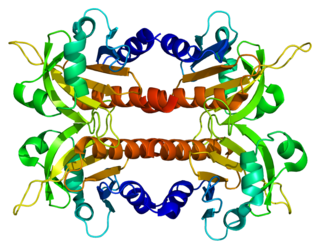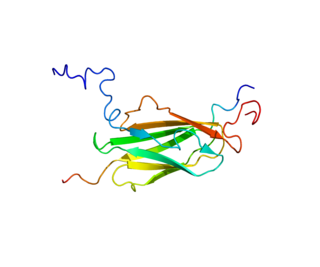
ENA/VASP homology proteins or EVH proteins are a family of closely related proteins involved in cell motility in vertebrate and invertebrate animals. EVH proteins are modular proteins that are involved in actin polymerization, as well as interactions with other proteins. Within the cell, Ena/VASP proteins are found at the leading edge of Lamellipodia and at the tips of filopodia. Ena, the founding member of the family was discovered in a drosophila genetic screen for mutations that act as dominant suppressors of the abl non receptor tyrosine kinase. Invertebrate animals have one Ena homologue, whereas mammals have three, named Mena, VASP, and Evl.

Profilin-1 is a protein that in humans is encoded by the PFN1 gene.

Vasodilator-stimulated phosphoprotein is a protein that in humans is encoded by the VASP gene.

Neural Wiskott–Aldrich syndrome protein is a protein that in humans is encoded by the WASL gene.

Zyxin is a protein that in humans is encoded by the ZYX gene.

Thyroid receptor-interacting protein 6 is a protein that in humans is encoded by the TRIP6 gene.

WAS/WASL-interacting protein (WIP) is a protein that in humans is encoded by the WIPF1 gene.

ArgBP2 protein, also referred to as Sorbin and SH3 domain-containing protein 2 is a protein that in humans is encoded by the SORBS2 gene. ArgBP2 belongs to the a small family of adaptor proteins having sorbin homology (SOHO) domains. ArgBP2 is highly abundant in cardiac muscle cells at sarcomeric Z-disc structures, and is expressed in other cells at actin stress fibers and the nucleus.

FYN binding protein (FYB-120/130), also known as FYB, ADAP, and SLAP-130 is a protein that is encoded by the FYB gene in humans. The protein is expressed in T cells, monocytes, mast cells, macrophages, NK cells, but not B cells. FYB is a multifunctional protein involved in post-activation T cell signaling, lymphocyte cytokine production, cell adhesion, and actin remodeling.

Profilin-2 is a protein that in humans is encoded by the PFN2 gene.

Protein diaphanous homolog 1 is a protein that in humans is encoded by the DIAPH1 gene.

Ena/VASP-like protein is a member of the Ena/VASP family of proteins that in humans is encoded by the EVL gene.

FH1/FH2 domain-containing protein 1 is a protein that in humans is encoded by the FHOD1 gene.

LIM and SH3 domain protein 1 is a protein that in humans is encoded by the LASP1 gene.

Acid-sensing ion channel 2 (ASIC2) also known as amiloride-sensitive cation channel 1, neuronal (ACCN1) or brain sodium channel 1 (BNaC1) is a protein that in humans is encoded by the ASIC2 gene. The ASIC2 gene is one of the five paralogous genes that encode proteins that form trimeric acid-sensing ion channels (ASICs) in mammals. The cDNA of this gene was first cloned in 1996. The ASIC genes have splicing variants that encode different proteins that are called isoforms.

Filamin-binding LIM protein 1 is a protein that in humans is encoded by the FBLIM1 gene.

Ras-associated and pleckstrin homology domains-containing protein 1 is a protein that in humans is encoded by the RAPH1 gene.

The Actin assembly-inducing protein (ActA) is a protein encoded and used by Listeria monocytogenes to propel itself through a mammalian host cell. ActA is a bacterial surface protein comprising a membrane-spanning region. In a mammalian cell the bacterial ActA interacts with the Arp2/3 complex and actin monomers to induce actin polymerization on the bacterial surface generating an actin comet tail. The gene encoding ActA is named actA or prtB.

Amyloid beta A4 precursor protein-binding family B member 1-interacting protein (APBB1IP), also known as APBB1-interacting protein 1 or Rap1-GTP-interacting adapter molecule (RIAM) is a protein that in humans is encoded by the APBB1IP gene.
WH1 domain is an evolutionary conserved protein domain found on WASP proteins, which are often involved in actin polymerization.

























